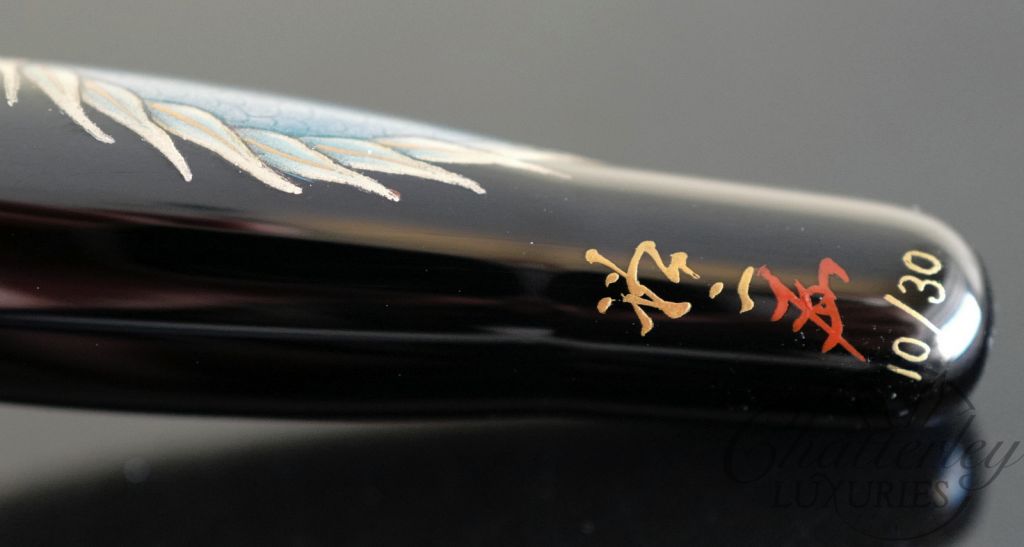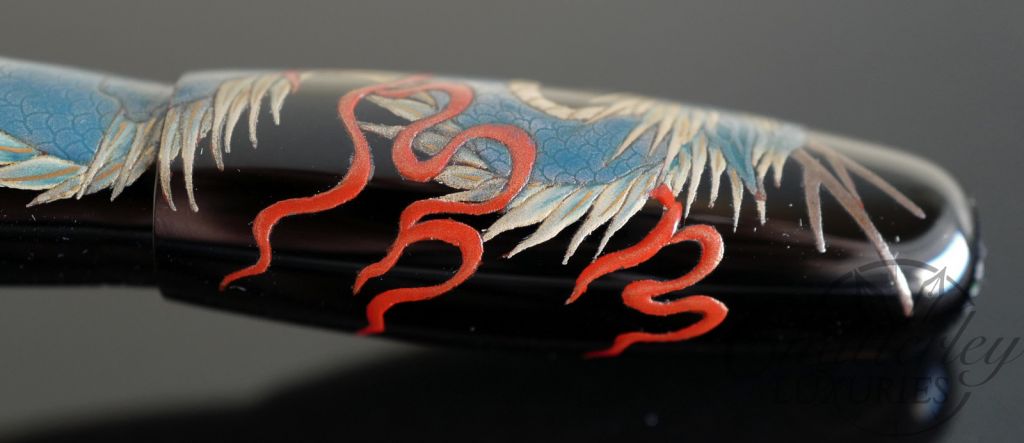Danitrio Maki-e Blue Dragon by Yuji Limited Edition on Hyotan Fountain Pen
Dragons have long been a legendary creatures in Japanese mythology and folklore.
This Pen is a Limited Edition of only 30 pens worldwide. Pretty much every Danitrio pen is a limited edition as they make so few of each pen, but this one is a numbered Limited Edition. Also, this design is normally only done on Mikado, which retails for $12,000. So this pen is quite unique in that regard. Its one of the nicest Dragon pens I’ve seen not on a Mikado or Genkai.





Danitrio makes remarkable hand painted pens using the Japanese skill and craftsmanship that has been mastered over the last few thousand of years. One of their lines of pens is the Hakkaku, which is an octagonal pen (8 sided faceted pen). This pen shows some of the detail work that is painstakingly managed to create art on a functional pen, meant to last for many many decades. The pen fills via cartridge convertor and is sporting a size #6 18kt gold nib.
Good basic paintings start with base painting, which the craftsmen paint twice or three times with Urushi mixed with finishing powders to make the base hard and durable. Then followed by the interim paintings which is done by one or two layers preparing for finishing paintings.
The base for Urushi paintings must be smooth and strong in order to have a good Urushi painting, which will last thousands of years. When the base is ready for painting, the first painting uses Sabi, Urushi mixed with polishing powders, as its base painting and call it Shita-nuri, the base painting. Then, Naka-nuri, the interim painting with Urushi is preparing for better Uwa-nuri, the finishing part of painting. The color of the interim painting has to be selected according to the color of the finishing part of painting. All these works are usually done by Nu-shi, craftsmen of Urushi paintings, painting 7 times in average and it takes 2-3 weeks before the Nu-shi can send back the pens to our Maki-e sh, who will do more Urushi painting works or Maki-e onto the pens.
Basically, Tame-nuri (Ta as tag, me as met ) uses Suki Urushi, transparent (actually rather translucent) Urushi painted over the colored Urushi, which was already painted as the interim layer. If the Shu (red) Urushi was painted as the base color, and then, the transparent Urushi is painted, it is called Shu Tame-nuri or Shu-dame. And if Kuro (black) Urushi was painted first, and then, the transparent Urushi was painted over it, it is called Kuro-dame. After the transparent Urushi was painted, the pen will be finished by another finishing technique, either Togidashi or Hana-nuri, depending on the desired outcome.
There is no 100% transparent Urushi. The clearest Urushi still has a light brown or amber color. The interesting thing with Tame-nuri is when the transparent Urushi is painted over the color Urushi, the color will change because this transparent Urushi is NOT 100% transparent like man-made “Urushi” which is 100% clear.
The specialness of Urushi is that the Urushi has a layer of membrane and the color of the layer will be lighter and shinier, and the Tame-nuri will look lighter and shinier within several months to a year.
Craftsmen call Urushi is a living thing. Its qualities differ even from the same trees, but quality is different from the trunk or branches. Different qualities from different trees or different areas or countries. Then, crude Urushi must be refined to make more than 10 different qualities of Urushi for different usage. Now craftsmen have to pay more than $600.00 per pound for genuine Japanese Urushi, $250.00 for Urushi imported from China. They use it in different occasions and different places, while manmade Urushi or plastic paint only cost a few dollars a pound. Genuine Urushi is like pure gold only for fine jewelry and pure gold is too expensive for cheap works with cheap materials. The translucent Urushi has to be made with Japanese Urushi, because Urushi from China or Vietnam are all black and the sap from the trees and can never be refined to be Suke-Urushi.
MSRP $4000









